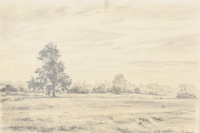Fritz Köhler
Fritz Köhler (born June 28, 1887, in Moritzberg near Hildesheim; died February 12, 1972, in Düsseldorf) was a German landscape and marine painter. Born Friedrich Köhler, he moved with his family to Hamburg in 1892 during the cholera outbreak, from which they were spared. In his youth, Köhler traveled the seas as a young sailor on merchant ships. From 1905 to 1907, he attended the Hamburg and Altona Art and Craft Schools. The director of the Hamburg Kunsthalle, Alfred Lichtwark, recognized Köhler’s talent and advised him to study in Weimar. Köhler then studied at the Weimar School of Applied Arts from 1909 to 1912 under Max Thedy and later as a master student of landscape painter Theodor Hagen.
After his studies, Köhler briefly established a studio in Hamburg, but by 1913, he relocated to Düsseldorf. During the Nazi period, he was a member of the militaristic artist group Westfront and was required to join the Reich Chamber of Fine Arts. His studio in Düsseldorf was destroyed in World War II, prompting his evacuation to Berchtesgaden. Köhler returned to Düsseldorf in 1945, where he worked in his final studio in the Düsseldorf Artists’ Association building on Sittarder Street. He was a member of the Reich Association of Visual Artists of Germany and the Düsseldorf artist association Malkasten, co-founded the 1949 Artists’ Group, and served on the board of the Düsseldorf heritage society, the Jonges.
Köhler exhibited widely, including in 1936 at the “Westfront. Free Art in the New State” in Essen, at the Great German Art Exhibitions in Munich (1941–1944), and at the Düsseldorf Artists’ Group 1949 in Düsseldorf. Köhler’s works are held in the Berlin National Gallery, the Hamburg Kunsthalle, and the North Rhine-Westphalia Art Collection in Düsseldorf. In 1967, he was awarded the Federal Cross of Merit, and the Fritz-Köhler-Weg in Düsseldorf-Wittlaer was named in his honor.
Showing all 8 resultsSorted by latest
-
Bleistiftzeichnung Dorfrand | Studie von Fritz Köhler, Düsseldorfer Maler
Fritz Köhler (1887-1971)
-
Bleistiftzeichnung Dorfrand | Studie von Fritz Köhler, Düsseldorfer Maler
Fritz Köhler (1887-1971)
-
Bleistiftzeichnung, Park Stadtrand | Studie von Fritz Köhler, Düsseldorfer Maler
Fritz Köhler (1887-1971)
-
Bleistiftzeichnung Flusslandschaft | Studie von Fritz Köhler, Düsseldorfer Maler
Fritz Köhler (1887-1971)
-
Bleistiftzeichnung Marterl Wegkreuz | Studie von Fritz Köhler, Düsseldorfer Maler
Fritz Köhler (1887-1971)
-
Bleistiftzeichnung Landschaft mit Haus | Studie von Fritz Köhler, Düsseldorfer Maler
Fritz Köhler (1887-1971)
-
Bleistiftzeichnung von Düsseldorf | Studie von Fritz Köhler, Düsseldorfer Maler
Fritz Köhler (1887-1971)
-
Landschaft | Studie von Fritz Köhler, Düsseldorfer Maler
Fritz Köhler (1887-1971)








